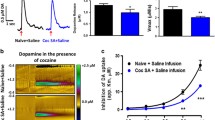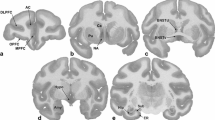Abstract
Rationale
Neurotoxin induced lesions of dopamine-releasing neurons that innervate the nucleus accumbens (NAcc) alter cocaine self-administration. In addition, elevated extracellular levels of NAcc dopamine (DA) are thought to be central to the biological mechanisms that underlie this behavior.
Objectives
This study assessed the long-term effects of 6-hydroxydopamine (6-OHDA) induced lesions of the NAcc on cocaine self-administration and the dialysate levels of dopamine ([DA]d) in this structure to determine if recovery of drug intake was correlated with the DA response.
Methods
Rats implanted with jugular catheters and bilateral cannulas were trained to self-administer cocaine and subsequently received bilateral intracranial micro-injections of 6-OHDA or vehicle into the NAcc. The levels of DA and cocaine were determined in microdialysates of the NAcc collected during experimental sessions 6–7, 14–16, 29–30, and 44–46 days post-treatment.
Results
The 6-OHDA induced lesions significantly reduced cocaine self-administration for 3 weeks while vehicle treatment had a moderate effect for the first several days. Cocaine-induced increases in NAcc [DA]d did not return to sham/vehicle treated control levels for 6 weeks in the lesioned group and DA content in the NAcc was 46% of control at 44 days post-lesion.
Conclusions
Although dopaminergic lesions of the NAcc produced profound effects on cocaine self-administration, responding recovered to control levels before cocaine-induced increases in NAcc [DA]d while content of DA in the NAcc did not recover. These data suggest that the plasticity of neuronal systems in the NAcc related to cocaine self-administration and their response following 6-OHDA lesions is more complex than restoration of DAergic tone.




Similar content being viewed by others
References
Angulo JA, Coirini H, Ledoux M, Schumacher M (1991) Regulation by dopaminergic neurotransmission of dopamine D2 mRNA and receptor levels in the striatum and nucleus accumbens of the rat. Mol Brain Res 11:161–166
Bourdelais A, Kalivas PW (1992) Apomorphine decreases extracellular GABA in the ventral pallidum of rats with 6-OHDA lesions in the nucleus accumbens. Brain Res 577:306–311
Breese GR, Duncan GE, Napier TC, Bondy SC, Iorio LC, Mueller RA (1987) 6-Hydroxydopamine treatments enhance behavioral response to intracerebral microinjection of D1- and D2-dopamine agonists into nucleus accumbens and striatum without changing dopamine antagonist binding. J Pharmacol Exp Ther 240:167–170
Brown ZW, Amit Z, Weeks JR (1976) Simple flow-thru swivel for infusions into unrestrained animals. Pharmacol Biochem Behav 5:363–365
Caine SB, Koob GF (1994a) Effects of dopamine D-1 and D-2 antagonists on cocaine administration under different schedules of reinforcement in the rat. J Pharmacol Exp Ther 270:209–218
Caine SB, Koob GF (1994b) Effects of mesolimbic dopamine depletion on responding maintained by cocaine and food. J Exp Anal Behav 61:213–221
Chritin M, Blanchard V, Raisman-Vozari R, Feuerstein C, Agid Y, Javoy-Agid F, Savasta M (1996) DA uptake sites, D1 and D2 receptors, D2 and proenkephalin mRNAs and Fos immunoreactivity in rat striatal subregions after partial dopaminergic degeneration. Eur J Neurosci 8:2511–2520
Co C, Smith JE, Lane JD (1982) Use of a single compartment LCEC cell in the determinations of biogenic amine content and turnover. Pharmacol Biochem Behav 39:799–802
DeWit H, Wise RA (1977) Blockade of cocaine reinforcement in rats with dopamine receptor blocker pimozide, but not with the noradrenergic blockers phentolamine or phenoxybenzamine. Can J Psychol 31:195–203
Di Chiara G, Imperato A (1988). Drugs abused by humans preferentially increase synaptic dopamine concentrations in the mesolimbic system of freely moving rats. Proc Natl Acad Sci USA 85:5274–5278
Gerber GJ, Wise RA (1989) Pharmacological regulation of intravenous cocaine and heroin self-administration in rats: a variable dose paradigm. Pharmacol Biochem Behav 32:527–531
Gong W, Neill D, Justice JB (1996) Conditioned place preference and locomotor activation produced by injection of psychostimulants into ventral pallidum. Brain Res 707:64–74
Gong W, Neill D, Justice JB (1997) 6-Hydroxydopamine lesion of ventral pallidum blocks acquisition of place preference conditioning to cocaine. Brain Res 754:103–112
Hemby SE, Smith JE, Dworkin SI (1996) The effects of etichlopride and naltrexone on cocaine, heroin, and cocaine/heroin combination self-administration. J Pharmacol Exp Ther 277:247–258
Hemby SE, Co C, Koves TR, Smith JE, Dworkin SI (1997) Differences in extracellular dopamine concentrations in the nucleus accumbens during response-dependent and response-independent cocaine self-administration in the rat. Psychopharmacology 133:7–16
Hubner CB, Morton JE (1991) Effects of selective D1 and D2 selective antagonists on cocaine self-administration in the rat. Psychopharmacology 105:151–156
Jongen-Relo AL, Docter GJ, Jonker AJ, Vreugdenhil E, Groenewegen HJ, Voorn P (1994) Differential effects of dopamine depletion on the binding and mRNA levels of dopamine receptors in the shell and core of the rat nucleus accumbens. Mol Brain Res 25:333–343
Klüver H, Barrera EA (1953) A method for the combined staining of cell and fibers in the nervous system. J Neuropathol Exp Neurol 12:400–403
König JFR, Klippel RA (1974). The rat brain: a stereotaxic atlas of the forebrain and lower parts of the brainstem. Kreiger Publishing, Huntington, New York
Koob GF, Vaccarino FJ, Almaric M, Bloom FE (1987) Positive reinforcement properties of drugs: search for neural substrates. In: Engel J, Oreland L (eds) Brain reward systems and abuse. Raven Press, New York, pp 35–50
Lacosta S, Roberts DC (1993) MDL 72222, ketanserin, and methysergide pretreatments fail to alter breaking points on a progressive ratio schedule reinforced by intravenous cocaine. Pharmacol Biochem Behav 44:161–165
Lane JD, Pickering CL, Hooper ML, Fagan K, Tyers MB, Emmett-Oglesby MW (1992) Failure of ondansetron to block discriminative or reinforcing stimulus effects of cocaine in the rat. Drug Alcohol Depend 30:151–162
Maldonado R, Robledo P, Chover, AJ, Caine SB, Koob GF (1993) D-1 dopamine receptors in the nucleus accumbens modulate cocaine self-administration in the rat. Pharmacol Biochem Behav 45:239–242
Mandel RJ, Hartgraves SL, Severson JA, Woodward JJ, Wilcox RE, Randall PK (1993) A quantitative estimate of the role of striatal D-2 receptor proliferation in dopaminergic behavioral supersensitivity: the contribution of mesolimbic dopamine to the magnitude of 6-OHDA lesion-induced agonist sensitivity in the rat. Behav Brain Res 59:53–64
McGregor A, Roberts DCS (1993). Dopaminergic antagonism within the nucleus accumbens or the amygdala produces differential effects on intravenous cocaine self-administration under fixed and progressive ratio schedules of reinforcement. Brain Res 624:245–252
Murray B, Shizgal P (1996). Physiological measures of conduction velocity and refractory period for putative reward-relevant MFB axons arising in the rostral MFB. Physiol Behav 59:427–437
Napier TC, Maslowski-Cobuzzi RJ (1994) Electrophysiological verification of the presence of D1 and D2 dopamine receptors within the ventral pallidum. Synapse 17:160–166
Newman-Tancredi A, Cussac D, Brocco M, Rivet J-M, Chaput C, Touzard M, Pasteau V, Millan MJ (2001) Dopamine D2 receptor-mediated G-protein activation in rat striatum: functional autoradiography and influence of unilateral 6-hydroxydopamine lesions of the substantia nigra. Brain Res 920:41–54
Nisenbaum ES, Stricker EM, Zigmond MJ, Berger TW (1986) Long-term effects of dopamine-depleting brain lesions on spontaneous activity of type II striatal neurons: relation to behavioral recovery. Brain Res 398:221–230
Nisenbaum ES, Stricker EM, Zigmond MJ, Berger TW (1988) Spontaneous activity of type II but not type I striatal neurons is correlated with recovery of behavioral function after dopamine-depleting brain lesions. Brain Res 473:389–393
Panagis G, Miliaressis E, Anagnostakis, Spyraki C (1995). Ventral pallidum self-stimulation: a movable electrode mapping study. Behav Brain Res 68:165–172
Parsons LH, Koob GF, Weiss F (1995) Serotonin dysfunction in the nucleus accumbens of rats during withdrawal after unlimited access to intravenous cocaine. J Pharmacol Exp Ther 274:1182–1191
Peltier P, Schenk S (1991) GR38032F, a serotonin 5-HT antagonist, fails to alter cocaine self-administration in rats. Pharmacol Biochem Behav 39:133–136
Pettit HO, Justice JB (1989) Dopamine in the nucleus accumbens during cocaine self-administration as studied by in vivo microdialysis. Pharmacol Biochem Behav 34:899–904
Pettit HO, Ettenberg A, Bloom FE, Koob GF (1984) Destruction of dopamine in the nucleus accumbens selectively attenuates cocaine but not heroin self-administration in rats. Psychopharmacology 84:167–173
Phillips GD, Howes SR, Whitelaw RB, Robbins TW, Everitt BJ (1994) Isolation rearing impairs the reinforcing efficacy of intravenous cocaine on intra-accumbens d-amphetamine: impaired response in intra-accumbens D1 and D2/D3 dopamine receptor antagonists. Psychopharmacology 1115:419–429
Porrino MC, Ritz MC, Goodman NL, Sharpe LG, Kuhar M.J, Goldberg SR (1989) Differential effects of the pharmacological manipulations of serotonin systems on cocaine and amphetamine self-administration in rats. Life Sci 45:1529–1535
Richardson NR, Piercy MF, Svennson K, Collins RJ, Myers JE, Roberts DCS (1993) Antagonism of cocaine self-administration by the preferential autoreceptor antagonist, (+)-AJ76. Brain Res 619:15–21
Roberts DCS, Vickers G (1984) Atypical neuroleptics increase self-administration of cocaine: an evaluation of a behavioral screen for antipsychotic activity. Psychopharmacology 82:135–139
Roberts DCS, Corcoran ME, Fibiger HC (1977) On the role of ascending catecholaminergic systems in intravenous self-administration of cocaine. Pharmacol Biochem Behav 6:615–620
Roberts DCS, Koob GF, Klonoff P, Fibiger HC (1980) Extinction and recovery of cocaine self-administration following 6-hydroxydopamine lesions of the nucleus accumbens. Pharmacol Biochem Behav 12:781–787
Robinson TE, Castaneda E, Whishaw IQ (1990) Compensatory changes in striatal dopamine neurons following recovery from injury induced by 6-OHDA or methamphetamine: a review of evidence from microdialysis studies. Can J Psychol 44:253–275
Robledo P, Koob GF (1993) Two discrete nucleus accumbens projection areas differentially mediate cocaine self-administration in the rat. Behav Brain Res 55:159–166
Sizemore GM, Co C, Smith JE (2000) Ventral pallidal extracellular fluid levels of dopamine, serotonin, gamma amino butyric acid, and glutamate during cocaine self-administration in rats. Psychopharmacology 150:391–398
Smith JE, Koves TR, Co C (2003) Neurotransmitter turnover rates in brain regions of rats during intravenous cocaine self-administration. Neuroscience 117:461–475
Snyder GL, Keller RW Jr, Zigmond MJ (1990) Dopamine efflux from striatal slices after intracerebral 6-hydroxydopamine: evidence for compensatory hyperactivity of residual terminals. J Pharmacol Exp Ther 253:867–876
Suzuki M, Kawasaki Y, Murata M, Shibata R, Kurachi M, Mori H (1995) Effects of 6-hydroxydopamine lesions of the medial prefrontal cortex on local cerebral blood flow and D1 and D2 dopamine receptor binding in rats: a quantitative autoradiographic study. Eur Neuropsychopharmacol 5:95–101
Weeks JR (1962) Experimental morphine addiction: methods for automatic intravenous injections in unrestrained rats. Science 138:143–144
Weeks JR (1972) Long term intravenous infusions. In: Meyers RD (ed) Methods in psychobiology. Academic Press, New York, vol 2, pp 155–168
Wise RA, Bozarth MA (1985) Brain mechanisms of drug reward and euphoria. Psychiatr Med 3:445–460
Woolverton WL (1987) Evaluation of the role of norepinephrine in the reinforcing effects of psychomotor stimulants in rhesus monkeys. Pharmacol Biochem Behav 26:835–839
Woolverton WL (1992) Cocaine self-administration: pharmacology and behavior. NIDA Res Monogr 124:189–202
Zigmond MJ, Hastings TG (1998) Neurochemical responses to lesions of dopaminergic neurons: implications for compensation and neuropathology. Adv Pharmacol 42:788–792
Acknowledgements
The conduct of this experiment was consistent with the ethical standards outlined in "Principles of laboratory animal care" (NIH publication No. 80-23, revised 1996). This research was supported by grants from the National Institute on Drug Abuse: DA 03628, DA 06634 and DA00114.
Author information
Authors and Affiliations
Corresponding author
Rights and permissions
About this article
Cite this article
Sizemore, G.M., Co, C., Koves, T.R. et al. Time-dependent recovery from the effects of 6-hydroxydopamine lesions of the rat nucleus accumbens on cocaine self-administration and the levels of dopamine in microdialysates. Psychopharmacology 171, 413–420 (2004). https://doi.org/10.1007/s00213-003-1596-6
Received:
Accepted:
Published:
Issue Date:
DOI: https://doi.org/10.1007/s00213-003-1596-6




